Dung is a tidy word for an untidy substance — animal poop. When farmers talk about cow dung or chicken dung, they’ll probably call it manure instead. Some dung causes problems, like the runoff of pig dung into lakes and rivers, while other dung is used to help fertilize vegetable gardens. Dung is an Old English word, from a Germanic root — in Old High German, a tung was an underground room that was covered with dung for warmth.

By Sadia Ghazanfar1, Muhammad Sohail Sajid1, Hafiz Muhammad Rizwan2
The dung is animal feces which is basically use as a source of fuel. Two billion people in economically developing nations use biomass fuels such as dried animal dung, wood, and crop waste as their major source of domestic energy. Due to burning of biomass for cooking and heating purpose cause high indoor particle concentration. Due to high level of airborne particle matter respiratory infection occur like increase heart rate, chronic obstructive lung disease and cancer.
Three main factors underlie the physio chemical characteristic of domestic grazing animal dung: The species of animal, the physiological state of animal and quality of ingested herbage (Driven by plant community composition and climatic conditions). Given that animals use only small proportion of nutrients they ingest, dung represents significant transfers of organic matter and nutrients to the pasture, promoting spatial heterogeneity in soil nutrients and nutrient cycling via uneven returns. This heterogeneity has cascading effect on both plant and animal diversity at the local scale. Dung degradation and time to disappearance depends on both climate factors and coprophagous invertebrate activity. These invertebrates play a key role in modifying the properties of both animal dung and soil (aeration, water porosity), which in turn promotes microbial activities.
In general, large manure patches have an adverse effect on vegetation immediately below the dung, and lead to local rejection of herbage by grazing animals. In the longer term, dung has a positive effect on surrounding pasture growth which may last up to two years after dung disappearance. Whilst the chemical transformations of dung and effects on flora and fauna are relatively well-described, further work is needed to assess the importance of coprophagous insects for ecosystem services. Bioenergy can play an important role in country-level climate change mitigation strategies. In terms of production, the analyses estimate that, at the national level, approximately 57 million tons of cattle manure and 6 million tons of chicken manure are produced each year. At the regional level, the Middle Delta region has the highest cattle manure production of all regions, at 31 million tons per year, or 55 percent of total manure production in Pakistan. Furthermore, the Upper Pakistan region, which produces 13 million tons of cattle manure per year (23 percent) Pakistan which produces 10 million tons (19 percent), have the second and third highest production volumes.
Cattle manure is often used as soil amendment and may have other uses depending on local practices. of the crop residue assessment, maize stalks, rice straw, sugar cane bagasse and cotton stalk, pruning from certain fruit trees, and cattle manure have been identified as biomass sources that could potentially be used to produce bioenergy in Pakistan. Building on the estimated amounts of crop and livestock residues, the total available biomass was used to estimate the total maximum electricity potential, and the total maximum amount of LPG that could be substituted. The analysis indicates that Pakistan has the potential to produce bioenergy from crop residues such as maize stalks,
The assessment illustrates that there is potential to generate energy from agricultural residues in Pakistan with the aim of reducing dependence on and substituting fossil fuels. Naturally occurring pathogens in livestock and poultry manure badly effect on human health. Some parasites are present in manure like cryptosporidium, and Giardia , and their transmission in human are by Cryptosporidium Parvum and Giardia lamblia two protozoa that shad in animal dung with most concern. Healthy humans have no side effect and serious health risk.
However, the risk factor is high in elderly ,very young and the people hose have suppressed immune system like AIDS patient, organ transplant recipients and chemotherapy receiving patients. In some protozoa particularly Cryptosporidium can exist in high levels of chlorine. Symptoms in humans are characterized by watery diarrhea, vomiting and abdominal cramps, but infection is self-limiting in healthy people, with a duration of illness lasting days to a few weeks. Many parasitic worms stay in manure for long time in the absence of animal host and causes different disease in livestock especially in sheep and cattle.
For prevention of this type of diseases we should take some basic steps for animals as well as human health. Cleaning of farms should be daily basis. Proper dispose of manure and other filth from the premises. Feeding of cultivated fodders is more helpful in pasture born infections. The infected and healthy animals should never be mixed ,same as younger and older ones. Improved animal management and housing techniques can also be effective in reducing pathogen levels in animal waste. Fecal contamination of food or water has received the most attention as sources of exposure, but direct person-to-person and animal-to-person transmission has been reported Therefore, animal agricultural systems for land application currently allow pathogen levels more than the levels recommended for agricultural use of domestic or municipal wastes. This matter needs immediate attention because there are potentially big differences in the allowable or recommended pathogen loadings to land between human and animal wastes, despite the high concentrations of human pathogens that can be present in land applied animal wastes.